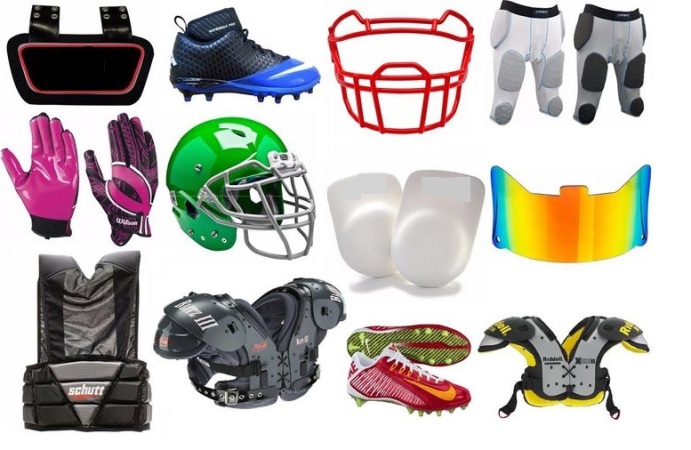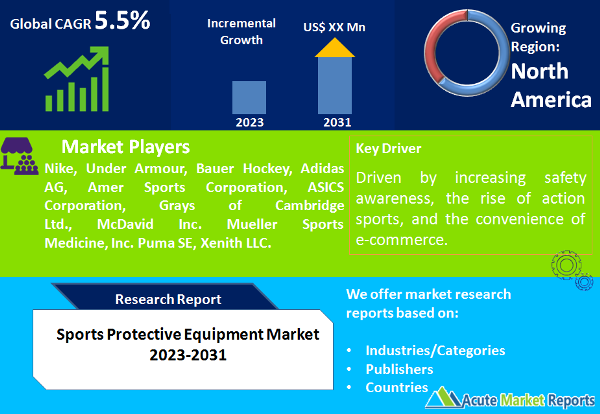
The sports protective equipment market is expected to grow at a CAGR of 5.5% during the forecast period of 2025 to 2033, driven by increasing safety awareness, the rise of action sports, and the convenience of e-commerce. While affordability concerns remain a challenge, ongoing innovations in materials and design are expected to address these issues. Additionally, the Women's segment presents untapped potential for market expansion as female participation in sports continues to grow. The Asia-Pacific region, with its vibrant sports culture and economic growth, is a focal point for market players. Leading companies are likely to continue innovating and expanding their presence in this region, ensuring that athletes worldwide have access to advanced and customized protective equipment. The future of the sports protective equipment market looks promising, with safety becoming an integral part of sports participation.

Increasing Awareness of Sports Safety
The paramount driver of the sports protective equipment market is the growing awareness of sports safety among athletes and sports enthusiasts. High-profile injuries have underscored the need for adequate protective gear, driving demand. Additionally, sports organizations and governing bodies are implementing stringent safety regulations, further boosting the market. Evidence includes injury statistics, media coverage of sports injuries, and safety regulations.
The popularity of Action Sports
The surge in the popularity of action sports such as skateboarding, snowboarding, and BMX biking has significantly contributed to the demand for sports protective equipment. These sports involve a higher risk of falls and collisions, making protective gear essential. The trend is supported by the proliferation of skate parks, snow resorts, and adventure sports events. Evidence includes participation statistics and growth in action sports events.
E-commerce and Online Retail
The advent of e-commerce and online retail platforms has revolutionized the sports protective equipment market. Consumers now have access to a wide range of products, brands, and price points, driving market growth. Online platforms offer convenience, product reviews, and a broader selection, influencing consumer purchasing decisions. Evidence includes e-commerce sales data, consumer preferences, and the digitalization of the retail landscape.
Affordability Concerns
A significant restraint in the sports protective equipment market is the affordability of high-quality gear. While safety is a priority, premium protective equipment can be expensive, deterring budget-conscious consumers. Affordability concerns are especially prevalent in regions with lower disposable incomes. Evidence includes pricing data, consumer surveys, and economic factors.
Product Segmentation: Head Protection Segment Dominates the Market
The market can be segmented into various product categories, including Head Protection, Face Protection, Upper Extremities Protection, Lower Extremities Protection, and Others (Eye and Ear Protection, etc.). In 2024, the Head Protection segment held the highest revenue share, emphasizing the importance of protecting the head in sports. However, during the forecast period from 2025 to 2033, the Face Protection segment is expected to exhibit the highest revenue and CAGR. This shift can be attributed to the increasing emphasis on facial safety in various sports and the development of advanced face shields and masks. Evidence includes sales data, product innovation, and injury reports.
Gender Segmentation: Men’s Segment Dominates the Market
The market can be further divided by gender, including Men, Women, and Unisex. In 2024, the Men's segment dominated the market due to the higher participation of men in sports. However, the Women's segment is expected to show the highest CAGR during the forecast period. This growth is propelled by the rising involvement of women in sports and the development of protective gear tailored to their specific needs. Evidence includes participation statistics, gender-specific product lines, and cultural shifts in sports.
North America remains the Global Leader
North America held the highest revenue percentage in the sport’s protective equipment market in 2024, driven by a sports-centric culture, high consumer awareness, and safety regulations. However, the Asia-Pacific region is expected to demonstrate the highest CAGR during the forecast period from 2025 to 2033. This growth is fuelled by the rapid expansion of sports infrastructure, increasing disposable incomes, and a burgeoning interest in sports across countries like China and India. As these economies continue to grow, more individuals have the financial means to invest in quality sports protective equipment, contributing to market expansion. Evidence includes regional revenue data, sports infrastructure development, and economic trends.
Market Competition to Intensify during the Forecast Period
In the competitive landscape of the Sports Protective Equipment Market, key players such as Nike, Under Armour, Bauer Hockey, Adidas AG, Amer Sports Corporation, ASICS Corporation, Grays of Cambridge Ltd., McDavid Inc. Mueller Sports Medicine, Inc. Puma SE, and Xenith LLC. are implementing several strategies to maintain and enhance their market positions. Innovation and product development are paramount, with companies investing heavily in research and development to introduce advanced materials and technologies that enhance both safety and comfort. Expansion into emerging markets, especially in the Asia-Pacific region, is another key strategy to capitalize on the growing interest in sports and rising disposable incomes. Furthermore, some companies offer customization and personalization services for protective gear, allowing customers to design and tailor their equipment to their specific requirements. Collaborations and sponsorships with professional sports leagues, teams, and athletes enhance brand visibility and provide valuable feedback for product improvement. These strategies collectively contribute to the overall competitiveness of key players in the market. Evidence includes company strategies, product innovations, and sponsorship agreements.
Historical & Forecast Period
This study report represents analysis of each segment from 2023 to 2033 considering 2024 as the base year. Compounded Annual Growth Rate (CAGR) for each of the respective segments estimated for the forecast period of 2025 to 2033.
The current report comprises of quantitative market estimations for each micro market for every geographical region and qualitative market analysis such as micro and macro environment analysis, market trends, competitive intelligence, segment analysis, porters five force model, top winning strategies, top investment markets, emerging trends and technological analysis, case studies, strategic conclusions and recommendations and other key market insights.
Research Methodology
The complete research study was conducted in three phases, namely: secondary research, primary research, and expert panel review. key data point that enables the estimation of Sports Protective Equipment market are as follows:
Market forecast was performed through proprietary software that analyzes various qualitative and quantitative factors. Growth rate and CAGR were estimated through intensive secondary and primary research. Data triangulation across various data points provides accuracy across various analyzed market segments in the report. Application of both top down and bottom-up approach for validation of market estimation assures logical, methodical and mathematical consistency of the quantitative data.
| ATTRIBUTE | DETAILS |
|---|---|
| Research Period | 2023-2033 |
| Base Year | 2024 |
| Forecast Period | 2025-2033 |
| Historical Year | 2023 |
| Unit | USD Million |
| Segmentation | |
Product
| |
Gender
| |
Price
| |
End-user
| |
Distribution Channel
| |
|
Region Segment (2023-2033; US$ Million)
|
Key questions answered in this report